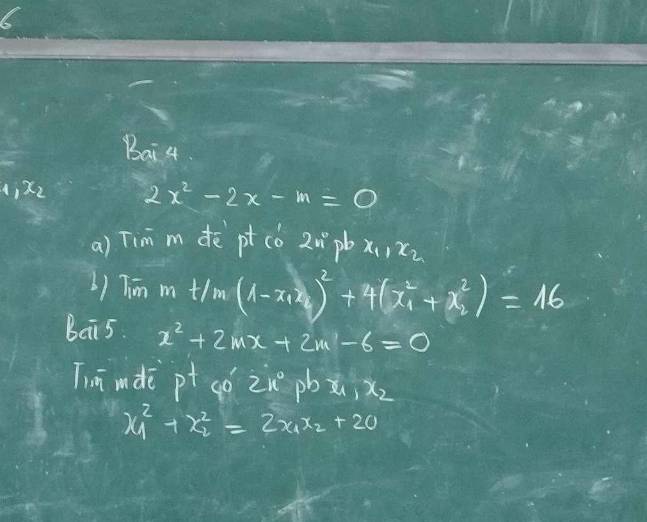
Hãy nhập câu hỏi của bạn vào đây, nếu là tài khoản VIP, bạn sẽ được ưu tiên trả lời.



Với n=0 \(\Rightarrow\) phương trình có 2 nghiệm duy nhất là \(\left\{{}\begin{matrix}x=-\dfrac{1}{2}\\y=\dfrac{1}{2}\end{matrix}\right.\)
Với n \(\ne0\)
Để phương trình có nghiệm duy nhất \(\Leftrightarrow\dfrac{n}{2}\ne\dfrac{2}{n}\Rightarrow n^2\ne4\Rightarrow n\ne\pm2\)
Vậy hệ phương trình có nghiệm duy nhất \(\forall n\ne\pm2\)
cho mình hỏi có đúng với nghiệm nguyên không vì đề bài yêu cầu nghiệm nguyên ạ ?

a, - Thay m = 2 vào phương trình ta được :\(x+2\sqrt{x-1}-3=0\)
\(\Leftrightarrow2\sqrt{x-1}=3-x\)
\(\Leftrightarrow4\left(x-1\right)=x^2-6x+9\left(x\le3\right)\)
\(\Leftrightarrow4x-4=x^2-6x+9\)
\(\Leftrightarrow x^2-10x+13=0\)
\(\Leftrightarrow\)\(x=5\pm2\sqrt{3}\) ( TM )
b, Ta có : \(x+2\sqrt{x-1}-m^2+6m-11=0\)
\(\Leftrightarrow x-1+2\sqrt{x-1}+1-m^2+6m-11=0\)
\(\Leftrightarrow\left(\sqrt{x-1}-1\right)^2=m^2-6m+9+2=\left(m-3\right)^2+2\)
\(\Leftrightarrow\sqrt{x-1}-1=\pm\sqrt{\left(m-3\right)^2+2}\)
\(\Leftrightarrow\sqrt{x-1}=1\pm\sqrt{\left(m-3\right)^2+2}\)
\(\Leftrightarrow x=\left(1\pm\sqrt{\left(m-3\right)^2+2}\right)^2+1\ge1\) ( TM )
=> ĐPCM
a) Thay \(m=2\) vào phương trình
\(\Rightarrow x+2\sqrt{x-1}-3=0\)
\(\Leftrightarrow2\sqrt{x-1}=3-x\) \(\left(3\ge x\ge1\right)\)
\(\Rightarrow4x-4=9-6x+x^2\)
\(\Leftrightarrow x^2-10x+13=0\) \(\Leftrightarrow\left[{}\begin{matrix}x=5+2\sqrt{3}\left(loại\right)\\x=5-2\sqrt{3}\end{matrix}\right.\)
Vậy ...
b) Đặt \(\sqrt{x-1}=a\) \(\left(a\ge0\right)\)
\(\Rightarrow a^2+2a-m^2+6m-10=0\)
Ta có: \(\Delta'=m^2-6m+11\ge0\forall m\)
Vậy phương trình luôn có nghiệm với mọi m

Lời giải:
ĐK:.............
Đặt $\sqrt{2x^2+x+6}=a; \sqrt{x^2+x+2}=b$ với $a,b\geq 0$ thì PT trở thành:
$a+b=\frac{a^2-b^2}{x}$
$\Leftrightarrow (a+b)(\frac{a-b}{x}-1)=0$
Nếu $a+b=0$ thì do $a,b\geq 0$ nên $a=b=0$
$\Leftrightarrow \sqrt{2x^2+x+6}=\sqrt{x^2+x+2}=0$ (vô lý)
Nếu $\frac{a-b}{x}-1=0$
$\Leftrightarrow a-b=x$
$\Leftrightarrow \sqrt{2x^2+x+6}=\sqrt{x^2+x+2}+x$
$\Rightarrow 2x^2+x+6=2x^2+x+2+2x\sqrt{x^2+x+2}$ (bình phương 2 vế)
$\Leftrightarrow 2=x\sqrt{x^2+x+2}(1)$
$\Rightarrow 4=x^2(x^2+x+2)$
$\Leftrightarrow x^4+x^3+2x^2-4=0$
$\Leftrightarrow (x-1)(x^3+2x^2+4x+4)=0$
Từ $(1)$ ta có $x>0$. Do đó $x^3+2x^2+4x+4>0$ nên $x-1=0$
$\Rightarrow x=1$Vậy..........

Ta có: \(\dfrac{4\sqrt{x}}{3\left(x-\sqrt{x}+1\right)}=\dfrac{4\sqrt{x}}{3\left[\left(\sqrt{x}-\dfrac{1}{2}\right)^2+\dfrac{3}{4}\right]}\)
Lại có: \(4\sqrt{x}\ge0\) với mọi x
\(3\left[\left(\sqrt{x}-\dfrac{1}{2}\right)^2+\dfrac{3}{4}\right]>0\) với mọi x
\(\Rightarrow\) \(\dfrac{4\sqrt{x}}{3\left[\left(\sqrt{x}-\dfrac{1}{2}\right)^2+\dfrac{3}{4}\right]}\ge0\) với mọi x
Dấu "=" xảy ra \(\Leftrightarrow\) x = 0
Vậy ...
Chúc bn học tốt! (Mk ms nghĩ ra được GTNN thôi thông cảm!)
Còn tìm GTLN:
Ta có: \(\dfrac{4\sqrt{x}}{3\left(x-\sqrt{x}+1\right)}=\dfrac{4\sqrt{x}}{3\left[\left(\sqrt{x}-1\right)^2+\sqrt{x}\right]}\le\dfrac{4\sqrt{x}}{3\sqrt{x}}=\dfrac{4}{3}\)
Dấu "=" xảy ra \(\Leftrightarrow\) \(\sqrt{x}-1=0\) \(\Leftrightarrow\) x = 1
Vậy ...
Chúc bn học tốt!


Bài 5:
\(x^2+2mx+2m-6=0\)
\(\text{Δ}=\left(2m\right)^2-4\left(2m-6\right)\)
\(=4m^2-8m+24\)
\(=4m^2-8m+4+20\)
\(=\left(2m-2\right)^2+20>=20>0\forall m\)
=>Phương trình luôn có hai nghiệm phân biệt
Theo Vi-et, ta có:
\(\left\{{}\begin{matrix}x_1+x_2=-\dfrac{b}{a}=\dfrac{-2m}{1}=-2m\\x_1x_2=\dfrac{c}{a}=\dfrac{2m-6}{1}=2m-6\end{matrix}\right.\)
\(x_1^2+x_2^2=2x_1x_2+20\)
=>\(\left(x_1+x_2\right)^2-2x_1x_2-2x_1x_2=20\)
=>\(\left(-2m\right)^2-4\left(2m-6\right)=20\)
=>\(4m^2-8m+24-20=0\)
=>\(4m^2-8m+4=0\)
=>\(\left(2m-2\right)^2=0\)
=>2m-2=0
=>2m=2
=>m=1(nhận)
Câu 4:
a: \(2x^2-2x-m=0\)
\(\text{Δ}=\left(-2\right)^2-4\cdot2\cdot\left(-m\right)\)
\(=4+8m\)
Để phương trình có hai nghiệm phân biệt thì 8m+4>0
=>8m>-4
=>\(m>-\dfrac{1}{2}\)
b: Theo Vi-et, ta có:
\(\left\{{}\begin{matrix}x_1+x_2=\dfrac{-b}{a}=\dfrac{-\left(-2\right)}{2}=\dfrac{2}{2}=1\\x_1x_2=\dfrac{c}{a}=\dfrac{-m}{2}\end{matrix}\right.\)
\(\left(1-x_1x_2\right)^2+4\cdot\left(x_1^2+x_2^2\right)=16\)
=>\(\left(1+\dfrac{m}{2}\right)^2+4\cdot\left[\left(x_1+x_2\right)^2-2x_1x_2\right]=16\)
=>\(\left(\dfrac{m+2}{2}\right)^2+4\left[1^2-2\cdot\dfrac{-m}{2}\right]=16\)
=>\(\dfrac{1}{4}\left(m^2+4m+4\right)+4\left(1+m\right)=16\)
=>\(\dfrac{1}{4}m^2+m+1+4+4m-16=0\)
=>\(\dfrac{1}{4}m^2+5m-11=0\)
=>\(m^2+20m-44=0\)
=>(m+22)(m-2)=0
=>\(\left[{}\begin{matrix}m+22=0\\m-2=0\end{matrix}\right.\Leftrightarrow\left[{}\begin{matrix}m=-22\left(loại\right)\\m=2\left(nhận\right)\end{matrix}\right.\)
5.
\(\Delta'=1+2m\)
a.
Phương trình có 2 nghiệm pb khi:
\(1+2m>0\Rightarrow m>-\dfrac{1}{2}\)
b.
Khi pt có 2 nghiệm, theo hệ thức Viet: \(\left\{{}\begin{matrix}x_1+x_2=1\\x_1x_2=-\dfrac{m}{2}\end{matrix}\right.\)
\(\left(1-x_1x_2\right)^2+4\left(x_1^2+x_2^2\right)=16\)
\(\Leftrightarrow\left(1-x_1x_2\right)^2+4\left(x_1+x_2\right)^2-8x_1x_2=16\)
\(\Leftrightarrow\left(1+\dfrac{m}{2}\right)^2+4.1^2+4m=16\)
\(\Leftrightarrow\dfrac{m^2}{4}+5m-11=0\Rightarrow\left[{}\begin{matrix}m=2\\m=-22< -\dfrac{1}{2}\left(loại\right)\end{matrix}\right.\)
5.
\(\Delta'=m^2-\left(2m-6\right)=\left(m-1\right)^2+5>0;\forall m\)
Pt luôn có 2 nghiệm pb
Theo hệ thức Viet: \(\left\{{}\begin{matrix}x_1+x_2=-2m\\x_1x_2=2m-6\end{matrix}\right.\)
\(x_1^2+x_2^2=2x_1x_2+20\)
\(\Leftrightarrow\left(x_1+x_2\right)^2=4x_1x_2+20\)
\(\Leftrightarrow4m^2=4\left(2m-6\right)+20\)
\(\Leftrightarrow m^2-2m+1=0\Rightarrow m=1\)





Ta có bài toán quen thuộc sau:
Nếu \(\left(x+\sqrt{x^2+1}\right)\left(y+\sqrt{y^2+1}\right)=1\) thì \(x+y=0\)
Do đó từ giả thiết ta chỉ cần chứng minh được \(\left(x+\sqrt{x^2+1}\right)\left(y+\sqrt{y^2+1}\right)=1\) thì bài toán được giải quyết.
Đặt \(\left\{{}\begin{matrix}x+\sqrt{x^2+1}=a>0\\y+\sqrt{y^2+1}=b>0\end{matrix}\right.\) \(\Rightarrow\left\{{}\begin{matrix}\sqrt{x^2+1}=a-x\\\sqrt{y^2+1}=b-y\end{matrix}\right.\)
\(\Rightarrow\left\{{}\begin{matrix}x^2+1=a^2+x^2-2ax\\y^2+1=b^2+y^2-2by\end{matrix}\right.\) \(\Rightarrow\left\{{}\begin{matrix}2ax=a^2-1\\2by=b^2-1\end{matrix}\right.\)
\(\Rightarrow\left\{{}\begin{matrix}x=\dfrac{a^2-1}{2a}\\y=\dfrac{b^2-1}{2b}\end{matrix}\right.\)
Thế vào giả thiết:
\(\left(\dfrac{a^2-1}{2a}+\sqrt{1+\left(\dfrac{b^2-1}{2b}\right)^2}\right)\left(\dfrac{b^2-1}{2b}+\sqrt{1+\left(\dfrac{a^2-1}{2a}\right)^2}\right)=1\)
\(\Leftrightarrow\left(\dfrac{a^2-1}{2a}+\sqrt{\dfrac{\left(b^2+1\right)^2}{\left(2b\right)^2}}\right)\left(\dfrac{b^2-1}{2b}+\sqrt{\dfrac{\left(a^2+1\right)^2}{\left(2a\right)^2}}\right)=1\)
\(\Leftrightarrow\left(\dfrac{a+b}{2}+\dfrac{a-b}{2ab}\right)\left(\dfrac{a+b}{2}-\dfrac{a-b}{2ab}\right)=1\)
\(\Leftrightarrow\left(\dfrac{a+b}{2}\right)^2-\left(\dfrac{a-b}{2ab}\right)^2=1\) (1)
Chú ý rằng: \(1=\dfrac{4ab}{4ab}=\dfrac{\left(a+b\right)^2-\left(a-b\right)^2}{4ab}\)
Do đó (1) tương đương:
\(\left(\dfrac{a+b}{2}\right)^2-\dfrac{\left(a-b\right)^2}{\left(2ab\right)^2}=\dfrac{\left(a+b\right)^2}{4ab}-\dfrac{\left(a-b\right)^2}{4ab}\)
\(\Leftrightarrow\dfrac{\left(a+b\right)^2}{4}\left(1-\dfrac{1}{ab}\right)+\dfrac{\left(a-b\right)^2}{4ab}\left(1-\dfrac{1}{ab}\right)=0\)
\(\Leftrightarrow\left[\dfrac{\left(a+b\right)^2}{4}+\dfrac{\left(a-b\right)^2}{4ab}\right]\left(1-\dfrac{1}{ab}\right)=0\)
Do \(a;b>0\Rightarrow\dfrac{\left(a+b\right)^2}{4}+\dfrac{\left(a-b\right)^2}{4ab}>0\)
\(\Rightarrow1-\dfrac{1}{ab}=0\Leftrightarrow ab=1\)
Hay \(\left(x+\sqrt{x^2+1}\right)\left(y+\sqrt{y^2+1}\right)=1\)
\(\Rightarrow x+y=0\Rightarrow P=100\)